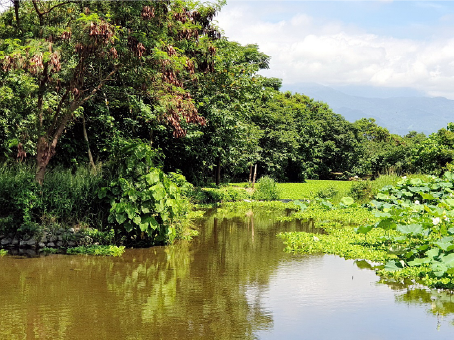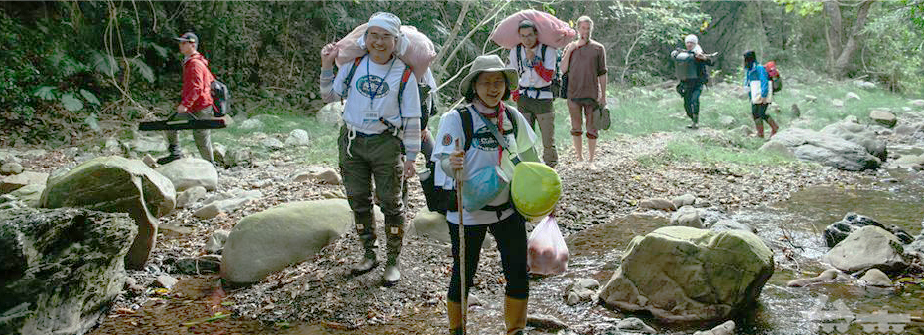 |
| Arteries of Life |
|
This year, we aim to present Taitung to the reader using a new, geo-thematic approach. We will explore the interplay between Taitung’s unique geographical features, environment and climate on the one hand, and the culture, economy and lifestyle of its inhabitants on the other. In doing so, we hope to impress upon the reader a deepened appreciation and heightened curiosity for our county. The first two issues of Taitung Times in 2024 explored Taitung’s plains and forests, this present third issue concerns itself with Taitung’s rivers, and we will successively cover islands and coasts, before finishing the year with a special edition dedicated to “spatial sacrality” in the county. THE RIVERS OF TAITUNG
 From the earliest human civilizations along the Tigris and Euphrates, Nile, Indus, and Yellow Rivers, natural waterways have served as the lifeblood nourishing both land and people. In Taitung County, the Beinan, Taimali, Zhiben, Dawu, and Daren rivers, snaking down from Taiwan’s Central Mountain Range, are more than emerald and blue geographic features carving through the forested mountain backdrop. They are threads woven into the very fabric of local culture, history, and spirituality, shaping the identity of this enchanting region. VEINS OF VITALITY

Just as the human body relies on arteries and veins to carry life-sustaining fluids, the rivers of Taitung serve as the veins that sustain the county's vibrant tapestry of life. From the mighty Beinan River, the longest in the county at 67km, to the countless streams trickling down from the Central Mountain Range, these waterways feed the precious lifeblood that nourishes Taitung's agriculture, industry, and everyday life. The rivers of Taitung play a crucial role in the county's economy and infrastructure. They provide water for irrigation, enriching the fertile fields that yield an abundance of agricultural goods, including Chishang rice, tea, sugarcane, atemoyas (or “custard apples”), pineapples, and pomelos. While these water-intensive crops greatly benefit from the region's river systems, some wild crops appear on the riverside without any encouragement and free for the taking, such as the starchy root vegetable “taro”, and the multifunctional shell ginger, which can be used for cooking, weaving, medicine, and decorations (in its flowering summer months). The rivers are also teeming with river shrimp and fish, just waiting to be caught. Together, these foods provide a large part of local nutritional needs and form the backbone of the blossoming slow food movement promoted by Magistrate April Yao and the county government. Moreover, these waterways are integral to Taitung’s critical infrastructure. Historically, they served as transportation routes, facilitating the movement of goods and people across rugged terrain. In recent times, some rivers have been developed to generate renewable energy or provide clean water. For instance, the Lijia Water Purification Plant generates clean energy before supplying clean drinking water to the residents of Taitung City. The Guanshan Canal Hydropower Plant has been providing electricity for over 1000 households on the local grid since 2017. Aligning with the county government’s sustainability ambitions, more small hydropower facilities will be constructed in various riverine zones, some of which are also protected indigenous lands. These new projects will prioritize shared benefits and respect for the tribal communities. Lastly, winding through areas of outstanding beauty, rivers are a key component of Taitung’s burgeoning ecotourism and outdoor industries. TAMING THE TORRENTS
 Flood stories are a common theme among the mythology of various Taiwanese Indigenous groups, reflecting shared experiences of great floods inundating their villages and destroying their worlds in ancient times. As Zhong Zhi-cheng explains, "Water symbolizes a carrier of limitless power and energy. It destroys then rebirths, creating new civilization" (Zhong, 2018). While rivers are the lifeline of Taitung, they can also unleash devastating fury during typhoon seasons or periods of heavy rainfall. Flooding, especially along the Beinan River, has been a recurring challenge for the county, with swollen rivers spilling over their banks and causing widespread damage to homes, farmlands, and infrastructure. Tragically, several people still die every year while river tracing, often due to drowning, flash floods and falling rocks. Aggravating the degradation and devastating potential of the rivers, has been the human activity and rapid development in the quest for material wealth and modernity, through which our civilisations largely alienated themselves from the natural systems that sustain us. In Taitung, in the past, this included sedimentation and erosion, pollution from industrial and agricultural activities, improper waste practices, and habitat destruction along the riverbanks. In response to these challenges, the county government has implemented a multifaceted strategy aimed at mitigating the impact of floods and preserving river ecosystems. This comprehensive approach includes riverbank reinforcement, construction of flood control dams, and the implementation of early warning systems to safeguard lives and livelihoods.  Maintaining the pristine state of the county is also a central tenet of Magistrate April Yao’s slow economy push and in line with these principles, the county has embraced sustainable practices to preserve the biodiversity of these vital waterways. Efforts are underway to restore degraded river banks and surrounding land areas, promote eco-friendly agricultural practices, and educate the public on the importance of maintaining healthy river ecosystems, as we are all the stewards of our waterways and our wider natural environment. A notable success story is the Taiping River that runs through the city of Taitung. Spearheaded by the county government, the Taiping projects incorporate flood prevention, ecological restoration, urban development, and community initiatives. The Taiping River Constructed Wetlands completed in 2022, allow for relaxing morning strolls along the river trail to appreciate the blooming white lotus flowers, while the wetlands fulfil their function as a sewage treatment facility. Native plant species have been reintroduced along the Taiping, resulting in a thriving ecosystem and renewed biodiversity. Flood prevention embankments, designed to double as roads and river paths, enhance accessibility and recreational opportunities along the riverbanks. The riverside area now features green parks and sports fields, inviting residents and visitors alike to enjoy a more intimate relationship with the river. Remarkably, some locals even bring their cattle to graze in these rejuvenated spaces during the dry season. CULTURAL CURRENTS AND SPIRITUAL STREAMS

The rivers of Taitung are intrinsically woven into the cultural tapestry of the region. Indigenous communities have long relied on these waterways for sustenance, transportation, and spiritual fulfilment. Indigenous communities' reverence for rivers extends beyond their practical and ecological value; it encompasses a deep spiritual connection rooted in their cultural identity and worldview, emphasizing the interdependence and interconnectedness of humans and the natural world. They have long revered these rivers as sacred entities, often personifying them as ancestors, guides, or benevolent spirits that bestow the gift of life. Traditional fishing techniques, such as the use of woven bamboo traps, have been passed down through generations, while rituals and ceremonies are performed to express gratitude and maintain a harmonious relationship with the water sources. The rivers have inspired rich traditions of storytelling and folklore among the various Indigenous groups in the area. Tales of river deities, supernatural beings, heroic feats and broken hearts have been shared around campfires and during festivals, helping to outline not only the landscape features, their dangers and their treasures, but also the moral traditions, taboos and conceptions of love and fidelity among the different tribes, thereby reinforcing the bond between the people and their freshwater lifelines. One such tale indicating interdependence with the waterways is a Puyuma (or Pinuyumayan) story about the Beinan River. The legend of Dugubis, from the Puyuma tribal village tells of a heroic figure who diverted the Beinan River to aid his people. Initially, the river did not flow near the village, making water collection difficult. Upon discovering a large lake during a hunting trip, Dugubis worked with village elders and undertook the task of redirecting the lake's water to the village, greatly improving irrigation and crop yields. To prevent flooding, he altered the river's course two more times, ensuring the safety and prosperity of the village by maintaining a stable and safe water supply. 
As shown, in Taitung, the rivers serve as more than just picturesque landscapes; they are gateways to Indigenous culture, reflecting a mosaic of ethnicities and traditions. Donghe Tribal House embodies this ethos, offering visitors a chance to partake in activities like bamboo rafting and hemp rope weaving then savour traditional Amis cuisine against the backdrop of the majestic Mawuku River. This unique blend of cultural immersion and natural splendour epitomizes the burgeoning trend of Indigenous ecotourism in the region. Similarly, at the Malaolou Trail, Chenggong Township, Amis guides offer an ecological experience as they take you river tracing up the Xingang River, incorporating a blend of hiking, survival skills, and culinary exploration. As participants traverse the rugged terrain and taste wild game, they also gain insights into the ecology and a deeper understanding of Indigenous ways of life.  Today, the rivers also provide urban refuge, where we can retreat from the everyday hustle and bustle of city life and clear our minds to a zen-like state. During the hot summer days, we can cool off with a dip in a cold spring; in the winter nights, sweat out our stress and toxins in the hot — the never-ending flow of the river providing a white noise backdrop as we bathe for rejuvenation or cleansing. The rivers are pathways for outdoor exploration with incredible river tracing spots, for example at the Mulberry Creek near the Rukai village of Taromak, but also spiritual pathways. Passing through enchanting landscapes as we journey to the source, searching for hidden waterfalls, reconnecting with nature and the self, gives us perspective on life's diverging paths and our place within the flow, allowing us to reflect upon our life choices and the next bifurcating stream, where we came from and where we are going. As the arteries that sustain life, the rivers of Taitung are not just physical entities but interweaving stories of cultural, spiritual, and ecological significance. Through proactive conservation efforts from the Taitung County Government under Magistrate April Yao, and a deep reverence for these vital waterways, we can preserve this invaluable legacy for generations to come. In our next edition, we will explore the coastlines that adorn Taitung's eastern shores, where the rivers meet the vast expanse of the Pacific Ocean, and discover the unique interplay between land and sea that defines this captivating region.
|
| © TAITUNG COUNTY GOVERNMENT 2024 |




